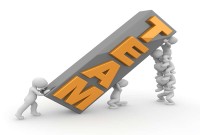- Home
- Business Processes
- Industry Knowledge
- Aerospace Industry
- Automotive Industry
- Banking Domain
- BFSI Industry
- Consumer/ FMCG Industry
- Chemicals Industry
- Engineering & Construction
- Energy Industry
- Education Domain
- Finance Domain
- Hospitality Domain
- Healthcare Industry
- Insurance Domain
- Retail Industry
- Travel and Tourism Domain
- Telecom Industry
- Leadership Skills
- eLearning
- Home
- Leadership
- Leadership Styles
- Types of Power in Leadership
Types of Power in Leadership
Power is the ability to exercise influence or control over others. Leadership involves authority and it is very important for leaders to understand what type of power they're using. The 5 Types of Power in Leadership are Coercive power, expert power, legitimate power, referent power, and reward power. Authority is the right to command and extract obedience from others. It comes from the organization and it allows the leader to use power.
In the functioning of a leader, the ability to guide the action of others is achieved through his or her authority. Carrying out of these decisions is accomplished because of the power of the leader. You will see the relationship between the authority and power of a leader as we go further to understand various types of power.
1. Legitimate Power:
This power comes to the leader when the organization’s authority is accepted. It comes from the rules of the organization. For e.g. parents, teachers, managers, police, etc. have legitimate power only when their authority is accepted in the positions they hold.
2. Expert Power:
This is the power of knowledge and skill of special kinds that is important in getting the job done. A person’s professional competence or knowledge gives him or her expert power. The credibility increases and he or she can lead other persons to trust the judgments and decisions taken by the leader. A leader may not be an expert in all fields, but one can certainly take the help of experts in particular fields as and when required.
3. Charismatic Power:
This is the power of attraction or devotion, the desire of one person to admire another. A subordinate feels a positive attraction towards a leader by identifying oneself, with the leader, or gets influenced by the leader’s attractive power. This power helps the subordinate to understand and value the leader so much that one understands and acts according to the expectations of the boss or the leader. It helps one to act as one’s own boss, and behave in ways one thinks the boss will want.
4. Reward Power:
This power is the present or potential ability to reward for worthy behavior. The superior or the leader has the power to give tangible rewards such as promotion, office space, time off from work, attractive work assignments, and help to the subordinate. Also, psychological rewards like praise, appreciation, approval, and recognition can be given by the leader or the superior to the subordinate. The subordinate has to believe that the leader has access to higher authorities; therefore, the leader can give rewards. This reward power of the leader can also increase the leader’s charismatic and legitimate power.
5. Coercive Power:
This is the ability to threaten or punish. The leader can give tangible punishment like dismissal, demotion, low rating, less satisfying work assignments, etc. Psychological punishments include criticism, avoidance, disapproval or satirical remarks, etc. on the subordinate. The reward power helps to avoid something undesirable. The self-esteem of the subordinate will increase because of reward power. It also decreases because of punishment or coercive power. Even a subordinate may withdraw or break the rules or become hostile. One may not feel attracted to the charismatic power of the leader and at times may ignore the leader’s legitimate power. Having seen the reasons for differences between the authority and power of the leader, you should know the type of leaders as understood on the basis of their authority and power.
Besides the power aspect one should also account for the following:
Formal Leader:
A formal leader is selected by the organization. For example, a manager is a formal leader by virtue of the authority coming from the organization. He or she influences others to help accomplish the goals of the organization or unit. Such leadership lasts over a long period of time.
Informal Leader:
An informal leader is chosen by the group. Thus, all managers are leaders if their authority is accepted, but not all leaders are managers. Informal leadership is leadership without position and may shift from one person to another. It may last for a brief time. Most people are leaders at one time or the other and they can have an influence on others as defined by the concept of leadership itself.
The ideal leader is the one who can combine formal and informal leadership simultaneously within himself or herself.
Related Links
You May Also Like
-
Process & Stages of Creativity
Creative ideas do not come just like that. There is a process to it. There are a number of techniques of creativity to support the generation of ideas but the widely practiced ones are brainstorming and lateral thinking. Most innovations are not so much the product of sudden insights as they are the result of a conscious process that often goes through multiple stages. The creative process can be divided into four stages of preparation, incubation, evaluation, and implementation.
-
The concept of management refers to the process of planning, organizing, staffing, directing, coordinating, and controlling to achieve organizational goals. It is the management of human, physical, financial, and other valuable resources of the organization in an effective and efficient manner to achieve business objectives.
-
Emergent leadership occurs when a group member is not appointed or elected as leader, but rather that person steps up as the leader over time within-group interactions. Have you ever faced challenges in getting accepted into your new role of position as a leader? Groups don't automatically accept a new "boss" as a leader. Emergent leadership is what you must do when taking over a new group. Learn more about emergent leadership.
-
Max Weber gave the theory of Bureaucratic Management in 1915. Bureaucracy is a specific form of organization defined by complexity, division of labor, professional management, and hierarchical management control. Weber's theory has two essential elements - organizational hierarchy and rules-based management. Weber made a distinction between authority and power and advocated that authority must be given to the most competent and qualified people.
-
Team Foundation in Forming Stage
This is the first stage of team development. This is the stage when the foundation of the team is laid. During the Forming stage, team members have a high dependence on their leader for guidance. Learn the practical strategies you can use during this stage to help your team develop into a highly effective performing team.
-
In this study of power, Raven identified five bases of power as coercive, reward, legitimate, referent, and expert. The 5 Types of Power can help you decide when it is appropriate to use a particular type of power in important situations. Leadership involves authority and it is very important for leaders to understand what type of power they're using.
-
All the teams are dynamic in nature and they take time to come together, they form, develop, and grow in stages, over a period of time. Teams go through five progressive stages: Forming, Storming, Norming, Performing and Adjourning. In this article, we want to introduce you to these stages of team development and certain strategies that you can use to help the team grow and develop in each of these stages.
-
Thinking & Problem Solving Skills
Today's dynamic business world demands that you make decisions that significantly boost productivity and drive competitive advantage. But how do you know whether a decision will benefit the organization? And how do you know that the decisions are based on rational and statistical reasoning? Explore how to become a dynamic problem solver with the skills to make accurate decisions.
-
Power is the ability to exercise influence or control over others. Leadership involves authority and it is very important for leaders to understand what type of power they're using. The 5 Types of Power in Leadership are Coercive power, expert power, legitimate power, referent power, and reward power. Authority is the right to command and extract obedience from others. It comes from the organization and it allows the leader to use power.
-
Taylor’s Scientific Management
Taylor’s theory of scientific management aimed at improving economic efficiency and labor productivity. Taylor had a simple view that money motivated people at work. He felt that workers should get a fair day's pay for a fair day's work, and that pay should be linked to the amount produced. He introduced the differential piece rate system, of paying wages to the workers.
Explore Our Free Training Articles or
Sign Up to Start With Our eLearning Courses

About Us
Learning
© 2023 TechnoFunc, All Rights Reserved










